2 The Lack of “Creativity” in Pre-Columbian Art: Terence Grieder’s Early Scholarship and Recent Rock Art Studies
James Farmer
https://doi.org/10.52713/YVEZ2354
Terence Grieder and “Creativity”
In his earliest scholarship, Terence Grieder set forth several broad-ranging concepts regarding the interpretation of ancient American art. Grieder was an avid proponent of the idea that in spite of deep-set historical classifications imposed on ancient American cultures (i.e. “Olmec,” “Maya,” “Anasazi” (aka “Ancestral Pueblo”), “Moche,” etc.), virtually all documented ancient American societies shared a basic set of fundamentally similar beliefs and ideologies. He was a strong believer in the idea that all ancient American art forms extending well into the past had always been technically, intellectually, and iconographically highly sophisticated. As a result of these two assertions, as well as his application of strict art historical analysis, the traditional notion of “creativity” in both ancient American archaeological and art historical scholarship warranted significant reconsideration. This essay considers aspects of Grieder’s earliest methodological approach to ancient American art history, as generally established in his earliest publications between 1961 and 1982, and the impact of his approach on recent studies of two early ancient American rock art traditions, specifically the Barrier Canyon Style centered in Utah and the Pecos River Style in southern Texas.
These styles have long been believed to be disassociated with any historic Native American peoples, and thus archeologically “extinct”. However, recent scholarship incorporating aspects of Grieder’s early pioneering methodology, in conjunction with expanded recording and documentation projects, are now establishing possible ancestral ties to later Puebloan peoples of the American Southwest, and Mesoamerican cultures of central Mexico, including the Mexica (Aztec) and historic Huichol. These ties may establish a more direct cultural context for these ancient painting traditions.
It was my good fortune to collaborate with Grieder for over 25 years on a number of research and scholarly endeavors. During that span, we had many, mostly rather social and informal discussions regarding historical research and interpretation (particularly as they intersected with current anthropological and archaeological methods and theories), so much of this essay may be understood as rooted in rather anecdotal information gleaned from those discussions. But much of this essay is also based on his and others’ published arguments and ideas regarding the methodological terrain of ancient American art historical scholarship as it evolved during his lifetime, primarily from his first scholarly publication in 1960 until the mid-1980s, when his focus had ultimately shifted firmly and permanently to Andean antiquity.
“Creation” (and its grammatical variations) is one of the most used and, Grieder would argue, most abused critical terms in the history of art historical scholarship. While Grieder did use the terminology in his own scholarship, he preferred to use it in rather cautious and restricted contexts, and I know of no particular publication in which he pointedly articulated his theoretical problem with the term. He was particularly conflicted by widespread popularized and romanticized uses of the term when applied somewhat loosely to describe significant artistic achievements in human history. Grieder drew a very clear intellectual distinction between two different understandings of artistic creativity. He generally opposed the romanticized concept of an artist or individual introducing or employing a new “idea” seemingly gleaned from nowhere and (in some ill-defined inspired manner) appearing or being injected into the artist’s consciousness through some mystical, supernatural fashion (i.e. divine intervention, trance-induced altered consciousness, etc.). This application of the concept most closely adheres to a standard Merriam-Webster’s Dictionary definition of the terminology, i.e. “to bring into being, beget, give birth to, cause to grow,” as derived from Latin creātus (Merriam-Webster Online).
Grieder much preferred, rather adamantly when provoked, the position that most if not all great human artistic advances frequently tagged as “creative” were in truth the result of rational, intellectual problem-solving, based on extensive experience, training and technical expertise, and cultural context and adaptation. He much preferred terminology such as “influenced by,” “appropriated/borrowed from,” “adapted from,” or even “evolved from.” In numerous personal critiques of my own work (and perhaps others as well) over the years, he fondly reminded me that human beings “had really ever had only one truly creative idea” (Grieder, personal communication, 1990), that occurred at (and perhaps even fostered) the very earliest evolutionary stages of human thought in the modern homo sapien mind. That idea was essentially the intellectual capacity to manipulate natural materials, including but not limited to the human body, to express thoughts and ideas that exceeded basic survival needs and would otherwise be inexpressible in specific forms (as in “make art”). This reflected a capacity for abstract and symbolic thinking which seemingly exceeded the mental capacity of other life forms (such as a concept of “nature”). For Grieder, that represented the only truly “creative” idea that the human race had ever experienced. Creation in that sense was not an occasional divine spark or biological anomaly, but an ongoing, ever-evolving aspect of human intelligence, in essence the history of humanity.
From that perspective, occasional and sporadic acts of “creation” throughout human history, including those of artistic merit so romantically popularized as such in much traditional art historical scholarship, were in actuality innovative ways of combining, reorganizing, or re-prioritizing basic ideas that had always been part of the nature of modern human thought. As reported or documented by uninformed contemporaries or backward-looking historians without proper context, such acts are easily seen as acts of true genius or “creativity”. One goal of sound art historical scholarship therefore (according to Grieder at the time, though now strongly supported by many modern scholars (Stokstad and Cothren 2020: 15), is to determine the cultural mechanisms of communication and transmission which provided the context and opportunity to the art world of the time to initiate such innovations.
One of his long-running pet targets of this approach was scholarship on the renowned Renaissance master Michelangelo Buonarroti. Grieder had no particular issue with Michelangelo’s attested talent, but Michelangelo’s name itself had become (and still often is) intimately entwined with a perception of his so-called divine “creative process”, even to the point of his famously self-assigned nickname, “Il Divino” (the Divine One); he actively fostered a public perception of his talent as having “just popped out of his being fully formed, without any blood, sweat, and tears” (Keener 2019). Simona Cohen’s 1998 essay demonstrates how certain compositional changes introduced by Michelangelo into the painting of the Sistine Chapel ceiling, long considered examples of his divinely-inspired creative genius, were in fact very rational “methodological” adjustments in the aesthetic needs of the design and configuration of the ceiling (Cohen 1998: 61).
Grieder never clearly articulated a personal theory or methodological approach to art historical interpretation in his early writings prior to 1975. But the broad ideas and attitudes presented in the previous passage clearly underlie the majority of his art historical scholarship, though one must frequently read between the proverbial lines to ascertain this. Typically, he simply applied his particular approach to the material at hand and let the interpretive results stand for themselves.
Grieder published his first significant scholarly article, a descriptive report of the results of a small archaeological survey project he participated in at several Classic Maya sites in northern Guatemala (Grieder 1960). This early interest in Classic Maya art manifested itself more thoroughly in his 1962 dissertation (Grieder 1962). Over some 388 pages, Grieder provides an exhaustive formal and stylistic analysis of the complete body of documented Classic Maya ceramic vessels bearing representational imagery available at the time. His background as an artist intimately familiar with materials and techniques is evident in his approach. But he also integrates other methodological techniques, such as comparisons to other Maya media, somewhat subjective, critical entries on the aesthetics of Maya imagery, and extended analysis of Maya artists’ attempts to render illusionistic three-dimensional space on two-dimensional surfaces. Overall the dissertation reflects heavy art historical influence from George Kubler. Yet, it is very difficult to get a clear sense of Grieder’s methodological approach or even a clear thesis statement from anywhere in the entire document. Only after reading through the first 20-30 pages of text does the reader begin to get any sense about his methodology (it seems highly unlikely in today’s academic environment that such an omission in a dissertation would even be accepted by any accredited institution or program). “Chapter I: Techniques of Maya Pottery” is devoted to an extensive, detailed analysis of Maya pottery production techniques and materials, everything from clay compositions, temper, and firing temperatures to vessel building, forming and surface decoration (Grieder 1962: 68-87). He frequently cites modern and historic Maya ethnographies and applies them retroactively to Classic Maya pottery techniques. He assumes a substantial line of socio-cultural continuity and evolution from the Maya past to the present, interrupted by the occasional historical cultural disruptions (i.e. historic European contact, industrial age technologies, etc.) which are easily accountable for. He never provides any theoretical argument or justification for the use of this ethnographic method, he just does it! Literally the second sentence of the chapter states that “Often several kinds of clay were available and in use at a single site, as at Holmul, which used two in ancient times, and in modern pottery of the Chorotegan area described by Doris Stone.” (Grieder 1962: 68). Hence, the seeds of what would later define his better-established methodological position were already in place.
By the early 1960s, George Kubler was widely regarded as the preeminent scholar of Pre-Columbian art history, responsible in large part for incorporating the field into the broader, Western scope of traditional art historical scholarship (Sorensen). He was a staunch proponent of his so-called configurational method, a formalist-based methodology emphasizing the analysis of individual elements, their relationship within a given style, and any discernible iconographic references (i.e. “symbolism”; Koontz this volume). Grieder never overtly acknowledges this specific methodology as his official approach, though he does cite Kubler frequently throughout his dissertation. Grieder knew Kubler well, and Kubler was one of the acknowledged outside readers of his dissertation. In fact, a review of all of the outside readers of the dissertation draft listed in the Acknowledgements of the document reads like a veritable “Who’s Who” of Maya and Mesoamerican art and archaeological scholarship, both then and even today: Linton Satterthwaithe, Edwin M. Shook, Anna O. Shepard, Tatiana Proskouriakoff, Gordon Ekholm, William Coe, Georges Guillemin [sic], Stephan de Borhegyi, Carlos Navarrete, and Kubler all provided comments and critiques of early drafts of the manuscript; Frederick Hartt, the noted Renaissance art historian, signed the dissertation as the Graduate Chair of the Art Department (Grieder 1962: ii).
Mesoamerican, and particularly Maya scholarship was exploding across the academic world in the late 1950s and early 1960s, and the University of Pennsylvania was right in the middle of this explosion, primarily due to the Tikal Project, an extensive and comprehensive archaeological program sponsored by the University museum and conducted at Tikal, Guatemala between 1948 and 2008 (Moholy-Nagi 2012). The most significant excavations were conducted between 1956 and 1962, yielding, among many results, an extensive quantity of ceramic vessels. Grieder had easy first-hand access to this material, but he also depended heavily on recent archaeological reports from other sites and institutions for comparative imagery and data, especially Robert Smith’s Ceramic Sequence at Uaxactun, Guatemala from 1955. One can easily understand Grieder’s initial attraction to a study of Maya art in this environment, though conducted not from a strictly archaeological perspective, but as an art historical exercise.
Terence’s abiding “anti-creation” attitude regarding artistic innovation drove both the actual language he employed and the method he seemingly followed to arrive at specific conclusions regarding artistic innovations in Maya art. For example, when discussing Maya attempts to develop convincing techniques for rendering illusionistic three-dimensional space on flat surfaces, he makes numerous comparisons to a variety of Maya objects which display other renderings of illusionistic three-dimensional space, such as mural paintings and carved stone relief panels. He draws a comparison between the carved relief scene on Piedras Negras Lintel 3 (Figure 2.1), and a painted ceramic plate dubbed the Jaguar Sacrifice Plate (Grieder 1962: plate 29). In his discussion, he notes that:
… in “Lintel 3” this illusionistic effect [naturalistic space] is carried to a point far beyond that found in most Maya sculpture. This suggests that “Lintel 3” may show the influence of lost mural paintings,…(Grieder 1962: 169).
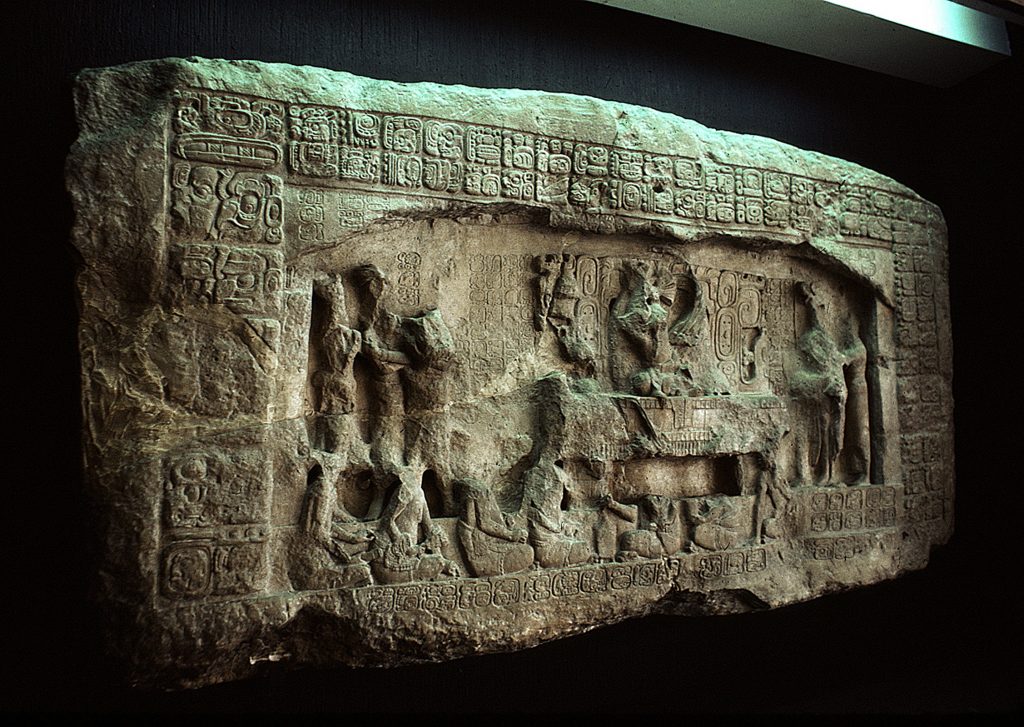
Photo by James Farmer, 2005; all rights reserved.
Though not definitively inaccurate, it still reads like a blatant assertion of an assumption presented as an established fact, yet he offers no information or argument to justify such an assertion. Some yet unidentified or lost work, style or artist must be exerting said influence on Piedras Negras sculptors in the development of new techniques; so-called independent invention (aka “creation”) cannot be credited for “Lintel 3”, and his strong belief in rational problem solving dictates that the source of inspiration simply hasn’t yet been identified. The dissertation is filled with similar assertions, yet nowhere does he take the time to clearly explain the theoretical basis for his approach.
Major advances were also occurring in the decipherment of Maya hieroglyphic writing and in archaeological theory and method, but these advances were only just beginning to disseminate through the academic community and public discourse. Tatiana Proskouriakoff’s seminal work on hieroglyphic translation at Piedras Negras was only recently published in 1960, and her follow-up work on hieroglyphic inscriptions from Yaxchilan wouldn’t be published until 1963-64 (Proskouriakoff 1960; 1963; 1964). The field of archaeology was in the early stages of a professional revolution as anthropologist Lewis Binford’s theories regarding what would come to be known as “Processual” (or “New”) Archaeology would only first be published in 1962 (Binford). Grieder would ultimately embrace much of Binford’s approach, but in his own somewhat mediated way, and not clearly articulated in his scholarship until much later.
Grieder subsequently condensed his dissertation arguments regarding Maya rendering of space and form into an article for the journal American Antiquity (Grieder 1964). Again, there is no clear methodological statement to frame the article. In his abstract for the article, he asserts that the Maya invented seven ways of showing solid forms and two ways of depicting spatial depth in their paintings, and then proceeds to demonstrate various instances in pottery and painting of the various techniques. Throughout the essay, he makes numerous statements that tend to read as unassailable arguments, or at best, unsubstantiated assertions, which he repeatedly offers as mere statements of fact:
The Maya never formulated a standard relationship even between the first and second dimensions – between length and width – for they did not have the conception of an angle as a measurable entity. (Grieder 1964: 447).
The statement is offered as definitively obvious, with no supporting evidence for the premise. Perhaps this is merely poor phrasing, but such categorical and borderline politically incorrect wording would probably never pass critical review by modern standards. Yet, such direct, definitive comments were always a part of Grieder’s literary “voice” and style.
Terence Grieder and Rock Art
Grieder did not publish as extensively on traditional rock art imagery (painted and/or pecked images on in-situ rock surfaces), as on his other topics of interest.1 But he was drawn to early rock art styles in the Americas because of his philosophical interest in the idea of “origins” and tracking the arc of stylistic influence, evolution and adaptation, as reflected in his support of the implications of the ethnological method (cultural evolution over long periods of time) combined with his anti-“creation” or diffusionist position, which dictated that any given style always owed something to its predecessors or foreign contemporaries. But for archaeologists and art historians alike, ancient or prehistoric rock art imagery has always been perhaps the most challenging art medium to interpret. It is notoriously difficult to date specific images or overall styles; specific artist’s identities or social affiliations are rarely available (though individual artist’s “hands” can sometimes be discerned); and cultural context is frequently completely lost, and can only be hypothesized or generalized. More recent archaeological techniques occasionally provide clues or data to address some of these issues, but the results of these methods are rarely universally accepted as completely accurate or valid, and these techniques have only been applied to an exceptionally small percentage of the documented rock art imagery across the Americas. And, of course, there is the ever-present lack of any direct ethnographic records, and in many cases no evidence of any direct ancestral relationship to any historically documented cultures (aka archaeologically “extinct”). Because of this, overall themes and specific subject matter of scenes and figures is typically limited to basic formal identifications; basic actions may often be determined if active figures are depicted. These difficulties usually relegate interpretations of more complex symbolism and iconography to the realm of hypothesis and speculation, again typically in only the most general terms.
Even basic formal traits so fundamental to any critical analysis of art works are often difficult or impossible to ascertain. Specific sizes and dimensions of individual elements and motifs may be measured, but many rock art panels incorporate natural features of the surrounding rock surface and landscape, considered in more detail below. How then should one determine the actual overall dimensions of a total composition? And even in the 21st century, the recording and cataloging of previously unreported rock art sites is very much an ongoing process. We still do not know how many examples of most major Ancient American styles were originally produced. And perhaps the most pervasive problem with rock art analysis is the constant threat to the medium’s very existence; under constant direct exposure to the forces of nature, including human and animal interference, natural erosion, and weathering, conservation of rock art imagery is now a major component of professional archaeological and government agencies around the world. Unknown quantities of images are disappearing or being altered on a daily basis with little or no associated documentation. In part because of these challenges, rock art imagery has only rarely been considered in major art history survey textbooks, the one obvious exception being the prehistoric cave art of Europe (i.e. Lascaux, etc.); scant acknowledgment of one of the oldest and most prolific forms of human visual expression.
Yet Grieder never lost sight of the broader implications of rock art studies for archaeological and art historical interpretation, most specifically that rock art imagery is the most common, widespread and at least the second oldest form of human visual expression (body adornment most certainly being the oldest and original form of such expression). Wherever humans have occupied space on the planet, with even the most meager natural landforms available, they have left behind rock art imagery of some form. To this end, any investigation of influences or context for the evolution of specific ancient styles or traditions, including iconographic readings, must surely consider possible influences of contemporary or more ancient rock art imagery, especially if such imagery could be tied to a given style or forms by complementary methodologies (i.e. ethnographic, archaeological and/or formal assignments).
His most in-depth interpretations of rock art imagery would be encapsulated in his 1982 book Origins of Precolumbian Art, considered below, but only as a relatively small portion of a much larger body of artistic expression, primarily body adornment and portable objects. In 1965 Grieder joined the Texas Archeological Salvage Project of the University of Texas to record archaeological sites in the Rio Grande River drainage west of Del Rio, Texas. Construction of Amistad Dam had just begun to create Lake Amistad reservoir, which threatened to inundate hundreds of undocumented ancient and historic painted rock art panels. Over a period of approximately three months, Grieder, with David Gebhard of the University of California at Santa Barbara, recorded some forty pictograph (painted) rock art sites in the region. The subsequent publication presented his detailed analysis of the painted imagery from twelve of the recorded sites (Grieder 1966). Gebhard had previously identified four distinct style variations within the rock art styles of the region (Gebhard), the most famous of which is now known as the Pecos River Style, presently dated between c.2000 BCE and 100 CE. But the relative dating and chronology of these styles was still unclear at the time. Grieder’s essay was an attempt to establish a basic chronological sequence for three of the four styles recorded in his survey. Although primarily a straightforward archaeological survey report describing the formal and technical aspects and physical condition of the pictographs, he includes what can only be described as a basic iconographic analysis (i.e. art historical methodology) of many elements to supplement his proposed chronology.
Grieder would return to Pecos River Style rock art twenty years later, in a 1986 essay in a catalogue published by the Witte Museum in San Antonio to accompany an exhibition focusing on the culture history of the same region. The exhibition was dominated by rock art imagery, and Grieder’s article proposed two principle problems facing students of ancient rock art: issues surrounding accurate recording and documenting rock art imagery (first-hand drawings vs. tracings vs. modern photographic techniques), and the assignment of “meaning” to elements and figures in a given style (Grieder 1986: 176). This second problem is as much an art historical issue as an archaeological one. Grieder’s methodology is much more clearly stated in this later article, though not until near its end. In the last paragraph, he states: “It is clear that the interpretation of Lower Pecos River petroglyphs rests on ethnology” (Grieder 1986: 179). He draws on several ethnographic sources from beyond the Pecos River region, including Plains, Woodland, and Zuni and Hidatsa myths and rituals, to aid in the interpretation of Pecos River Style scenes.
The 1986 essay must be understood, however, in the light of his 1975 essay “The Interpretation of Ancient Symbols”, published eleven years earlier, and his subsequent 1982 book Origins of Precolumbian Art. In the 1975 essay Grieder, for the first and perhaps only time, provides a reasonably clear argument regarding his methodological approach to art interpretation, especially as it relates to usually “pre-“ or non-literate societies of ancient America. He basically defines and then compares the advantages and disadvantages (as he saw them at the time) of Kubler’s configurational method (especially as Kubler had recently argued for in his seminal 1970 article on style, versus the “ethnological method” (aka ethnographic analogy), which had emerged from more recent anthropological scholarship as a method of artistic interpretation that challenged perceived limitations of Kubler’s configurational method (Kubler 1970; Koontz, this volume). Grieder appropriates Tatiana Proskouriakoff’s term “total cultural context” to refer to the results of interpretations drawn from the valid application of both methods to the same subject. In his concluding paragraph, he states:
Realistic expectations for the recovery and interpretation of ancient cultures must lie somewhere between the “total cultural context” required by Proskouriakoff (1950: 182) for understanding of the development of art, and the purely pictorial materials on which Kubler pins his hopes. (1975: 853)
The “awareness” of “disjunction” which Grieder notes in this passage refers to Kubler’s application of Erwin Panofsky’s “principle of disjunction” as a major objection to the use of the ethnological method. Kubler cites the danger of significant or extensive changes or breaks in cultural continuity, such as the shift from the Classical to the Medieval world in Europe, causing parallel shifts or changes (disjunctions) in the relationship between style (“form”) of art works, and their associated content (“subject matter” and “symbolism”). When the ethnological record fails to supply adequate information regarding the motivations for such changes, or even a clear definition of the mechanisms of the change itself, then erroneous or invalid interpretations of the associated art works are inevitable. Kubler adamantly pushed this critique of the ethnological method, but Grieder countered Kubler with the position that, yes, cultural changes or upheavals might indeed result in substantial “disjunctions”, but with the aid, especially in cases of prehistoric and non-literate societies, of well-done archaeological investigation, the impact of such disjunctions could be accommodated in any interpretations. For Grieder, disjunction was not a theoretical flaw in the ethnological method; it was an integral part to be properly addressed.
In many, though frequently overlooked, ways, the ‘Symbols’ article laid down some basic methodological approaches now widely used in ancient American art interpretation. But independently, neither methodology was universally accepted, and both methods engendered considerable controversy at the time and still today. Yet, the mixed acceptance of the 1975 article does not overshadow the impact of it on subsequent art historical research (as reflected in other essays in this volume). Maya scholar Michael Coe employed a similar synthetic methodology in his seminal 1978 analysis of Maya ceramics, Lords of the Underworld: Masterpieces of Classic Maya Ceramics (Coe), which convincingly demonstrated the importance of the role that ancient Maya creation mythology as recorded in the Popol Vuh played in understanding much pictorial Maya imagery, particularly on ceramics. More recently, Carolyn Boyd (2016) makes similar use of this methodology to yield an even more compelling (and somewhat controversial) interpretation of Pecos River Style rock art imagery considered below.
The 1975 ‘Symbols’ article was prepared and published while Grieder was involved in his first full-scale excavation project at the ancient site of Pashash, Peru. Grieder had been working at Pashash since 1969, and ultimately published The Art and Archaeology of Pashash (1978), his first book focused exclusively on ancient Pre-Columbian art of the Americas. Though primarily a summary analysis of the archaeological material and data recovered from his excavations, Grieder supplements his reporting with ample art historical analysis and interpretation, as befitting his earlier scholarship. Even the book title was no small matter, clearly declaring the book to be about both “art” and “archaeology” interpretation. As this was Grieder’s first time to serve as the director and principal investigator of a major archaeological project, as well as the primary author of the subsequent book, it is possible to understand the publication of the 1975 ‘Symbols’ essay as a (perhaps necessary) step to more firmly demarcating his own “theoretical” terrain (Koontz, this volume). In the introduction to Pashash, Grieder provides interesting comments on his view of the nature of historical inquiry as it underlies both art historical and archaeological practice. He notes, for example, that:
History is full of surprises. If it is not, then the investigation may have been a waste of time. Historical data are full of answers to questions one could not have asked until one saw the data. It is important that the value of history lies in its production of new knowledge that could not have been subsumed under a [previous] premise and that, in its conclusions, still resists reduction to generalizations. (Grieder 1978: 7)
Upon publication of the 1978 Pashash book, Grieder almost immediately began work on his next book project, Origins of Pre-Columbian Art (1982). In Origins Grieder expanded the scope of the approach presented in the 1975 article. He applied it to an expansive near-global interpretation (Asia, the entire Pacific basin, and the Americas) of the evolution of human cultures and associated art forms across the entire spectrum. Even by today’s standards, this was an extraordinarily grand and ambitious goal, but his confidence in the validity of his now-(more) clearly established method permitted him to develop the project. The reader is encouraged to review his book in depth to gain a more detailed understanding of the nuances and details of his assertions and conclusions; I offer for consideration herein merely a highly condensed summary of his major hypotheses. Grieder asserted that both Pacific basin and ancient American cultures had evolved through a three-stage process of cultural diffusion, which he designated “waves,” originating from the earliest human cultures in eastern Asia, migrating eastward over vast periods of time across the Pacific basin and ultimately into the Americas. Each successive wave emerges from, absorbs, and builds upon the previous set of cultural beliefs and ideologies, ultimately defining the cultural profiles and art styles of the major Pre-Columbian societies. Origins is the most grandiose reflection not just of his methodology, but of his underlying belief in the rational, intellectual capacity of the human mind and spirit.
However, while it draws directly from the 1975 article, it in fact presents a fundamentally different approach to the methodology. The earlier Pre-Columbian publications were more focused and “style specific”; they offered interpretations of specific works or bodies of works from specifically defined styles (configurational method), supported with ethnological sources as he deemed appropriate. The goal was to “explain” or assign better “meaning” to a particular style (Koontz, this volume). In Origins, in contrast, the goal is reversed; to demonstrate how the methodology can be applied to most any art tradition, regardless of questions of style or subject; that is, prioritizing the ethnological over the configurational.
I offer this very condensed abstract of the heart of Origins, without any assertion of its validity, merely to highlight what it reveals about Grieder’s methodological evolution. Reviews of Origins were generally positive, but rarely overwhelmingly so, often tempered by the theoretical challenges reflected in the book. Flora Clancy noted:
Another thing to consider is the breakdown of Asian and New World prehistory into three different cultures where one is defined as simple, one is complex, and one mediates between the two extremes. Structuring related phenomena into a trilogy made up of two extremes and an in-between is a common and convenient procedure…
Thus Grieder’s three cultures seem arbitrary: why not two, or four, or five? A method that was useful for structuring cultural traits into three coherent groups according to their complexity of associations and presumed meanings has been arbitrarily (?) deemed, as well, a description of three different and distinct cultures. (Clancy)
Yet she concludes that:
Terence’s contributions to this arena are valuable. Despite the questions of this review, his ideas are clearly stated and well argued. It is an easy book to read (a definite virtue) and it is highly recommended to anyone who wishes to enter into the discourse on the origins of cultures. (ibid)
Implicit in Grieder’s approach was an acceptance of the premise that ancient American cultures across the entire hemisphere had interacted and shared ideas with each other in much more intense and highly developed systems of communication than traditional archaeology and art history had generally acknowledged (in part fueling his discomfort with the deep-set historical classifications noted in the introductory paragraph). Southwestern archaeologist Steven H. Lekson has suggested rather blatantly that in the Ancient Greater Southwest, “Everyone Knew Everything!” (Lekson 2008: 9). In his opinion, most every major culture group throughout ancient North and Mesoamerica (and probably South America as well) was always well aware of who and what their cultural neighbors were and weren’t doing across almost the entire continent. Cultural and stylistic differences had little to do with cultural isolation or autonomy from the larger world. Such isolation, by theoretical extension, would foster classification of cultural change (i.e. artistic innovation) as examples of independent invention and/or “creation” (vis-à-vis Grieder’s “creation” model), as opposed to “adaptations” resulting from ongoing interaction with, or diffusion from, a variety of often “foreign” influences, the broader cultural context. Although Lekson does not cite Grieder directly, this view seems to reflect a philosophical position similar to Grieder’s heavily diffusionist model of culture spread, as opposed to independent “creativity.” Recent scholarship on the now-recognized extensive nature of pre-historic exchange networks throughout the entirety of ancient America offers more corroboration of Grieder’s hypothesis (Smith, Michael E.). Despite still current challenges of some aspects of his methodology, Grieder’s broad approach seems to have foreshadowed much current scholarly thinking.
Recent studies on ancient American rock art in the United States have begun to reflect the influence of his synthetic configurational / ethnological method. Carolyn Boyd’s recent publication on the White Shaman Mural presents a highly detailed analysis of a complex polychrome rock art panel in the Pecos River Style (Boyd 2016). The White Shaman Mural has long been well-known among rock art scholars and students of the Pecos River Style, but problems in dating, defining an archaeological or cultural context, and identifying many specific pictorial elements in the scene have long hindered serious attempts to interpret the scene (problems typical of most rock art research). At first glance to the untrained eye, the mural appears to be a confusing mass of abstract elements and motifs, with little or no apparent compositional unity or structure (Figure 2.2). It has often been suggested that the imagery in some vague way depicts visionary experiences by shamans in states of ecstasy or supernatural flight (Shafer 1986: 140). Using 21st century recording techniques (D-Stretch software, digital-field microscopy, and portable X-ray fluorescence) and updated field paintings and drawings, her team produced highly detailed technical data regarding the composition and application of pigments, allowing her to more accurately date the mural, and analyze in very specific detail the painting techniques and pigments.
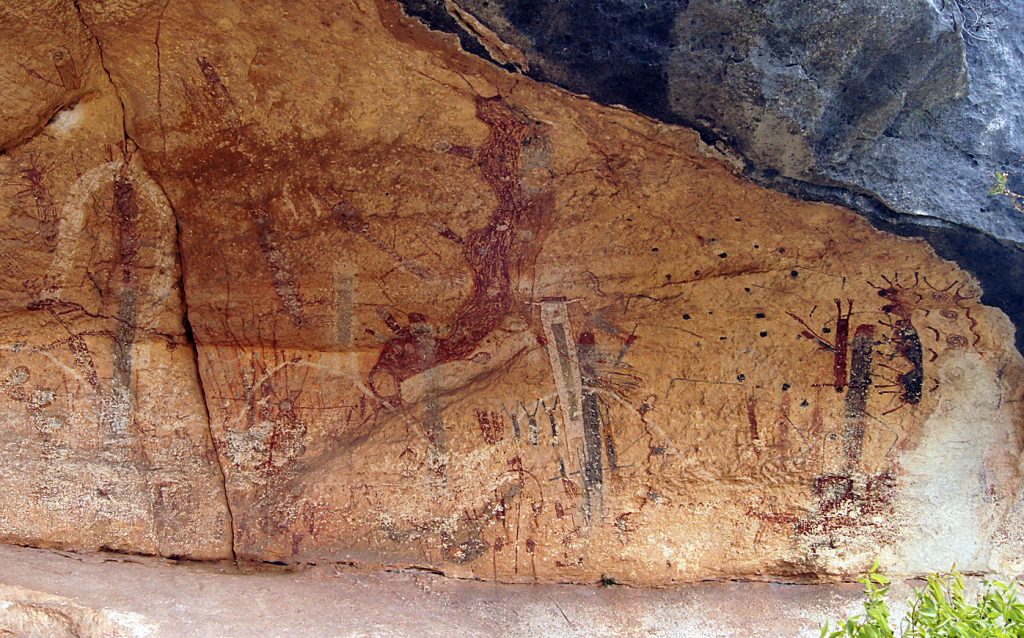
Photo by James Farmer, 2019; all rights reserved.
More significantly however, Boyd offers a revised iconographic reading of the entire composition. The presumption had long been held that possible connections with other northerly Southwestern cultures was likely because of the Pecos River region’s close proximity to the ancient Southwest, as opposed to the traditional area of ancient Mesoamerica to the south, and some basic similarities between the Pecos River Style and other archaic rock art styles from the Southwest, such as the Barrier Canyon Anthropomorphic Style (henceforth BCS Style) centered in southern Utah, first defined by Polly Schaafsma (1971: 131-135). In a rather bold and radical step, Boyd engages Southern Uto-Aztecan linguistics and ethnography, primarily Aztec/Nahuatl, as well as historic Huichol myths and legends, to assign various cultural and iconographic interpretations to the composition. The implications of this method are not without their challenges. Despite numerous extensive archaeological projects in the Pecos River area, virtually no hard archaeological evidence has ever surfaced suggesting a definitive ancient Mesoamerican presence in the immediate area. Furthermore, while Boyd gleans powerful iconographic readings from her Southern Uto-Aztecan sources, she generally avoids any similar readings from Northern Uto-Aztecan sources, which would include Hopi ethnographies. If indeed Uto-Aztecan linguistics are key to understanding the mural imagery, it would seem that a more equitable application of available linguistic sources might be expected, or at least some rationalization as to why the southern dialect is so appropriate, while the northern dialect is essentially ignored.
Despite these inconsistencies, I find her interpretations compelling and generally persuasive, and my point is not so much to critique her findings or assertions, as it is to place the results of her approach in relation to Grieder’s methodological modeling. Once again I would encourage any motivated reader to thoroughly review her book and associated reviews and related scholarship. While this is indeed a powerful application of Grieder’s original “ethnological” method to assign complex iconographic interpretations to the mural (and thus a negation of the mystically “created” nature of the images), a more formal or configurational interpretation of the mural in fact suggests much stronger formal affinities with Southwestern rather than Mesoamerican styles. Simply stated, stylistically the White Shaman Mural really doesn’t look much like any known style associated with any ancient Mesoamerican culture. It is worth noting that recent rock art studies have revealed a substantial amount of under-researched rock art imagery throughout northwestern Mexico, some of which may be related to the Pecos River Style (Liponi, Wyndham). Additionally, both Boyd and Carolyn Tate (this volume) point out general formal similarities between a few individual motifs and possible Mesoamerican equivalents. However, at this writing, little of these archaic rock art styles from the Southwest seems to be stylistically directly related to the traditional Mesoamerican styles to the south; the focus has been on iconographic interpretations. Hence any configurational analysis seems exceedingly weak in supporting any Mesoamerican connection, and in fact much more strongly supports a more northerly Southwestern cultural affiliation.
And this seems to highlight a potential flaw or weakness, or least an intellectual “pitfall” in Grieder’s approach. To his credit, Grieder does acknowledge this issue in the 1975 article. Accepting the relative validity of both Boyd’s and Schaafsma’s analyses, this situation might easily be understood as a clear demonstration of Panofsky’s “principle of disjunction” of form and meaning in styles spanning hundreds or thousands of years (Grieder 1975: 849). But it does reveal a rather peculiar aspect (call it a “flaw”, “weakness”, or even “failure”) in Grieder’s proposed synthetic method. Applying both methods (configurational and ethnological) in his model to interpret any given work or style, one of four theoretical results are to be expected:
- Both methods definitively reveal the same or reasonably similar interpretations; each method concurs with and supports the other method. This is the optimal outcome, providing the strongest line of interpretation for the subject.
- One method provides a strong interpretation, but the second method (regardless of which is which) yields little or no useful interpretive data to compare with that of the first method. This result typically relegates any final interpretation to a more speculative assertion, pending more research, but does not necessarily negate the interpretation offered by the first method.
- Neither method produces any substantial data from which any interpretations of the work might be formulated. Typically this indicates that, at least at this point of investigation, the object lacks enough basic contextual information (identification, associated styles, archaeological context, etc.) to produce fruitful interpretive results.
- One method produces strong data and evidence supporting one particular interpretation, usually of a specific aspect of the work (iconographic, authorship, patronage, cultural or stylistic affiliation, etc.), but the other method presents equally strong evidence supporting an opposing interpretation, sometimes even negating that of the first method. This result is obviously the most problematic, as it provides no real clarity in how to resolve the apparent conflict, and, worse, reveals, in a rather ironic way, a theoretical limit to the entire method. Each method independently seems to provide a valuable point of interpretation of an object, which is useful, but the lack of concurrence between, or negation of, the results between the methods tends to weaken each one.
Boyd’s analysis of the White Shaman Mural is a good example of result #4. Her iconographic reading of the mural based on Mesoamerican sources is strong and compelling, but a configurational (stylistic) analysis of the imagery reveals no such Mesoamerican interaction, and in fact supports much stronger ties to the greater American Southwest. At this time, it leaves the interpretive question somewhat unresolved for this particular rock art panel, but the question itself has been clarified somewhat. However, the interpretation of this particular work is not the focus here; rather I present it only as an example of how Grieder’s methodology can be applied to rock art imagery with some positive (if not always conclusive) results, while simultaneously recognizing the possible pitfalls.
I have experienced a similar situation in my own research on the aforementioned BCS Style of rock art distributed primarily across south-central Utah and the Colorado River Basin. While the greater American Southwest (including portions of northwestern Mexico) is widely regarded as one of the three or four great regions in the world for its quantity and diversity of ancient rock art styles, myself and numerous other rock art specialists have now long noted that a handful of these styles reflect formal, technical, and thematic qualities that noticeably distinguish them from the rest of the regional styles, to such a degree that they are more accurately categorized as “painting” rather than rock art styles. The aforementioned Pecos River Style, the BCS Style, and the Great Mural Tradition of Baja California (Crosby) are particular examples.
As noted by Lekson and Boyd, one of the longest running debates in the history of American archaeology has been the question of the ancient relationship between the ancient Greater Southwest and ancient Mesoamerica, or more specifically the nature of the interaction (if any) between the major cultures comprising the two regions. Over nearly a century and a half of anthropological research, scholarly theories have spanned the gamut of hypotheses, ranging between the assertion that the two cultural regions emerged over the centuries basically separate and autonomous from each, with only occasional and inconsequential contact, to the other extreme, positing that the two regions in fact constituted just one big, unified culture area that happened to display certain regional stylistic distinctions. This typically took the form of a much expanded Mesoamerica, with the Southwest serving as a kind of colony or satellite community. In recent years, a more mediated, complex, but probably more accurate position on this issue has generally been adopted; that while both regions maintained a high degree of cultural and linguistic autonomy, a significant amount of regional interaction and influence also occurred over a long period of time, primarily in the form of trade, that played a key role in the cultural evolution of both areas (see Lekson 2008; López Austin and López Lujan, 2001: 6-21).2
The BCS Style
My research on the BCS Style since the 1990s has landed me right in the middle of this Mesoamerican debate. In 2001 I noted specific formal, thematic, and possibly iconographic features of several BCS Style figures that displayed strong similarities to certain major Mesoamerican “gods,” specifically the Aztec Rain God Tlaloc and the Feathered Serpent Quetzalcoatl (Farmer 2001). At that time I considered them only as clear examples of artistic parallels between the two regions. Similar parallels had previously been noted for other prehistoric Southwestern imagery (Schaafsma 1999, 2001) from the late prehistoric period; my purpose was mainly to demonstrate that similar parallels actually extended well back in the antiquity of the Southwest.
BCS Style rock art panels have been documented since the early 20th century, but until Schaafsma’s 1971 publication, they were generally assigned to the ancient Fremont culture which flourished across most of modern-day Utah between c.1 and 1300 CE. (Janetski and Talbot 2014: 118; Morss 1931: 34-42). Schaafsma first recognized the distinctive nature of the style, assigning the name Barrier Canyon Anthropomorphic, and realized that it was not produced by the Fremont people, but rather earlier migratory, non-sedentary hunter-gatherer groups of the Archaic Period (c.6000 BCE – 1000 CE), roaming the landscape and exploiting natural floral and faunal resources. As such, they left no permanent architecture, and very little material culture or permanent art behind for the archaeological record, with the noticeable exception of rock art. However, much like the Pecos River Style, the BCS Style seems to have no apparent ancestral links to historic native cultures, and thus no directly-related ethnographic sources, at least until now. As such, interpretations have generally been limited to what little information archaeological techniques might yield, mostly in attempts to date the style (currently somewhere between c.6000 BCE and 1000 CE, with a peak period of activity between c.2000 BCE and 500 CE.), and variations of the Kubler / Grieder configurational analysis to define basic elements of the style. Iconographic interpretations of content have been limited to general assertions (and I would emphasize the term “assertions” here) of figures and activities relating to intensely spiritual subjects or activities, i.e. shamanism or spiritual transformation. Schaafsma first offered this interpretation in 1980, based primarily on her rather subjective conclusion that:
One senses that the remote, awe-inspiring anthropomorphic forms of the Barrier Canyon Style are beings imbued with supernatural power. It is not unreasonable, considering the content of the paintings, to suggest that we are dealing with a shamanic art (1980: 71).
This interpretation of BCS subject matter (and by implicit extension, matters of style, context, function, etc.) has permeated the scholarship on BCS Style imagery for the past 40 years.
The style is characterized by typically static, frontal-facing anthropomorphic figures, ranging between c.6 inches and 7 feet tall; less–frequently, such figures do occur in scenes of narrative activity. An intense, typically-blood red pigment (primarily iron oxide) is by far the most dominant hue used in BCS Style imagery, and the anthropomorprhs are frequently accompanied by a wide variety of animal and plant forms. The anthropomorphic figures are typically rather abstract, often lacking arms, legs, hands, or feet. Torsos are often highly decorated, but it is difficult to discern whether this represents body painting, some fashion of clothing, or perhaps even ceremonial reworking of the image itself. Head and facial features are extremely rare, with the exceptions of either occasional head adornment (a hat or a hairdo), and, most significantly, large, staring, often highly-exaggerated eyes, which have contributed heavily to the widespread assignment of a deeply spiritual meaning to the figures (shamans?; ghostly spirits?; ancestors?, mummies?, etc.).
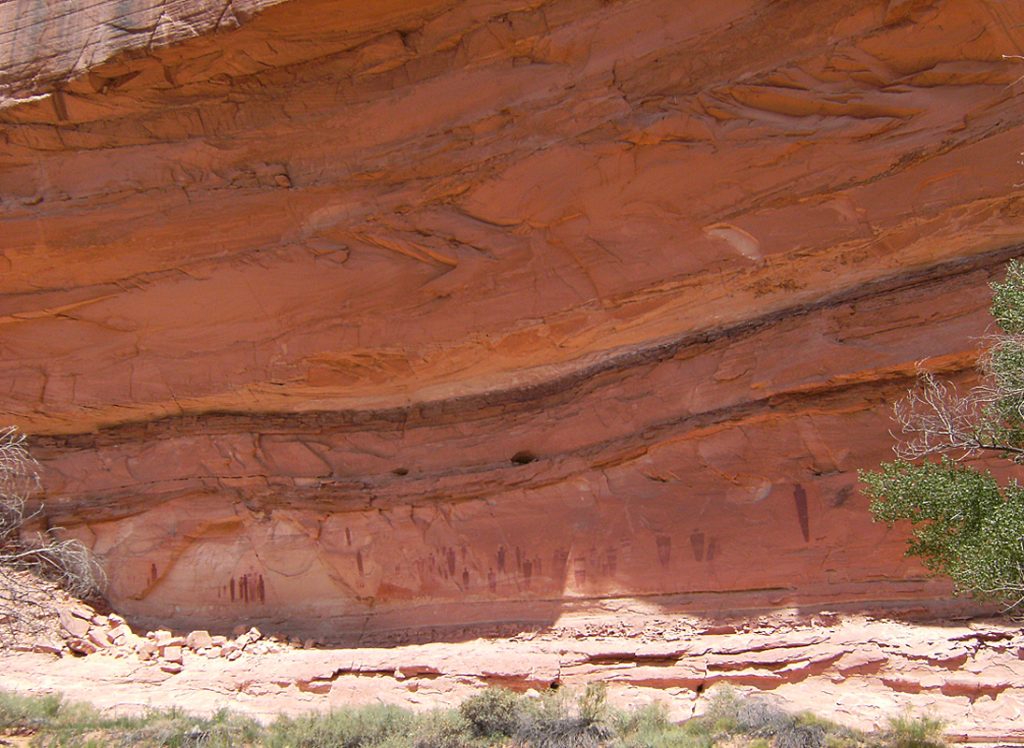
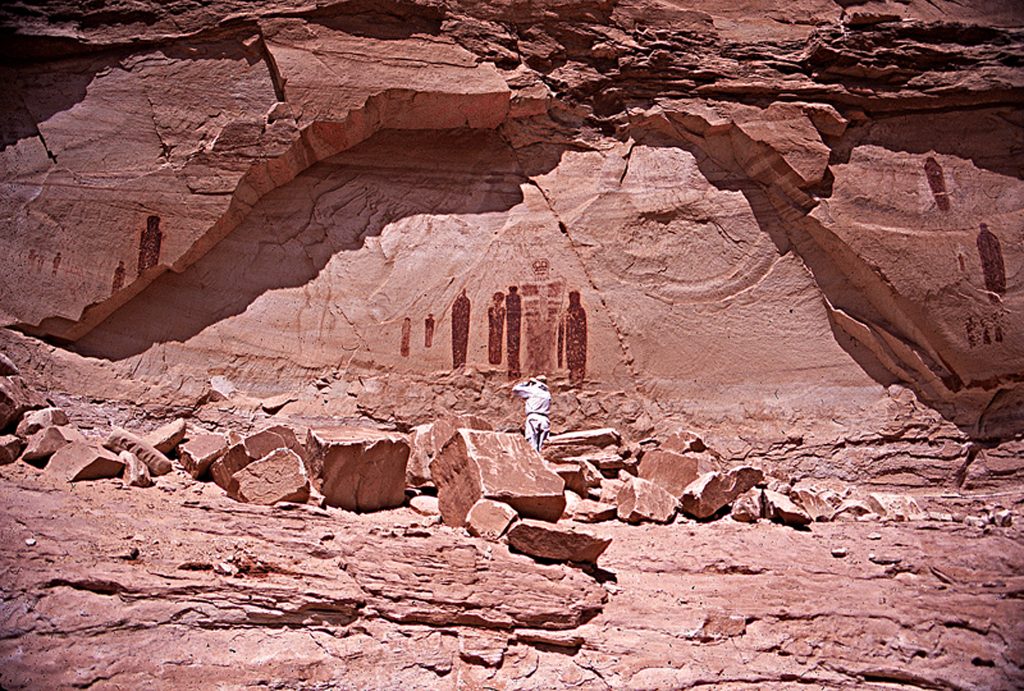
Photo by James Farmer, 2005; all rights reserved.
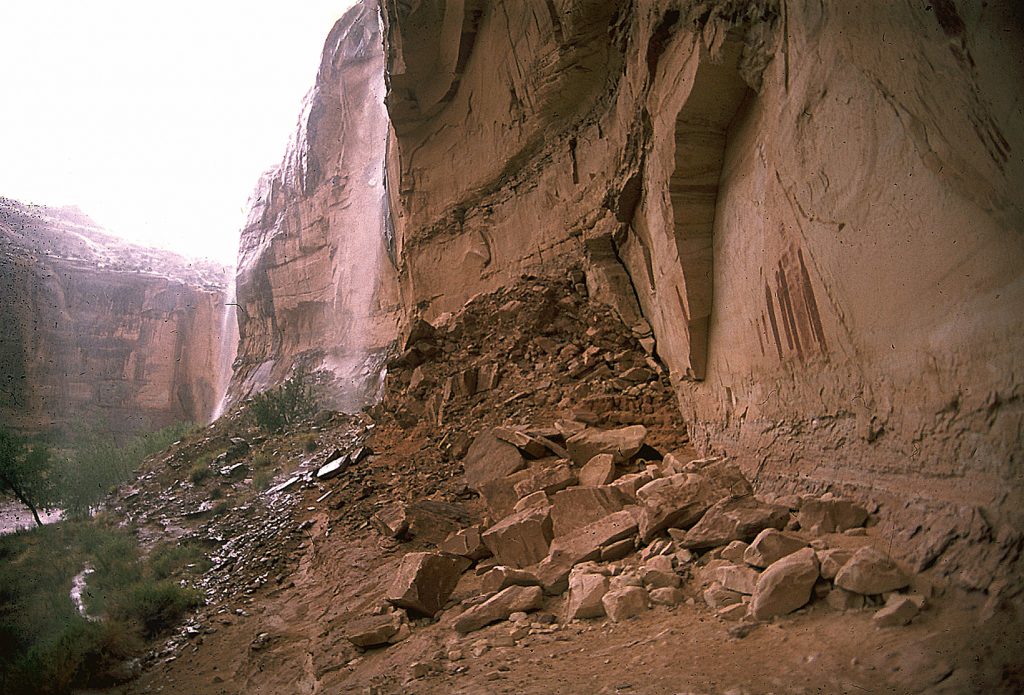
Photo by James Farmer, 2005; all rights reserved.
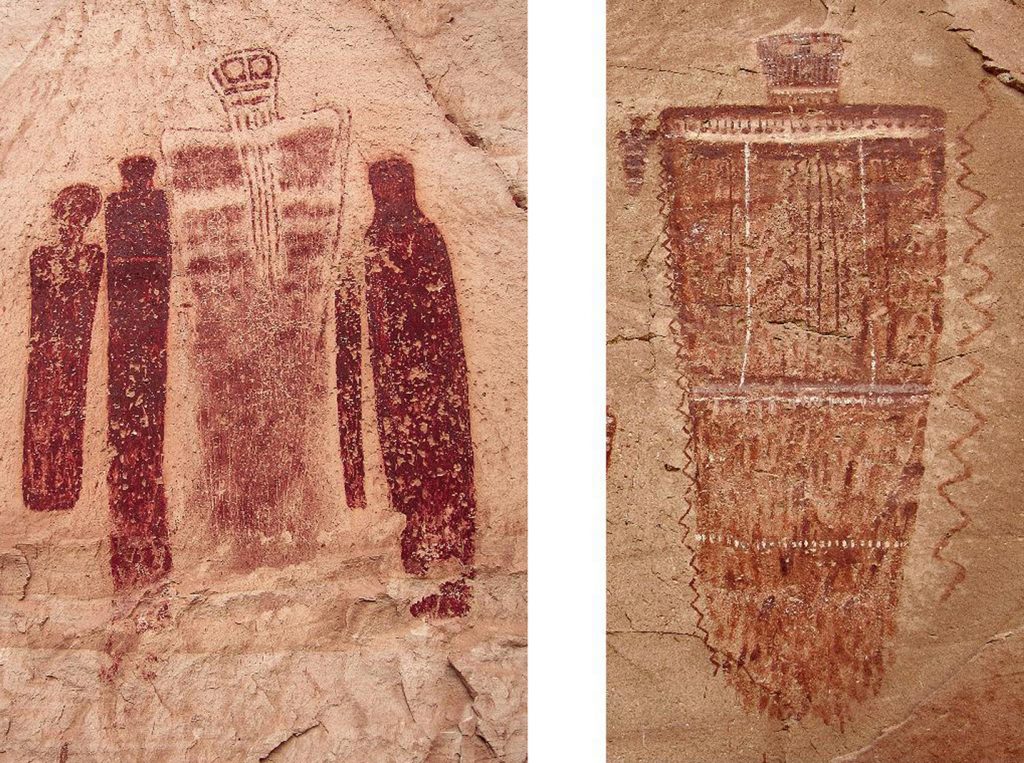
Left: Central figures of the Holy Ghost Panel (cf. Figure 2.4).
Right: Figure located along the same Great Gallery canyon wall (cf. Figure 3) approximately 50 feet to the right of the Holy Ghost Panel. Note the small-scale figure in the same BCS Style at the (viewer’s) left shoulder. Note the “waterfall” elements adorning the torsos of both large figures, and the vertical, zigzag serpents flanking the right figure.
Photos by James Farmer, 2007; all rights reserved.
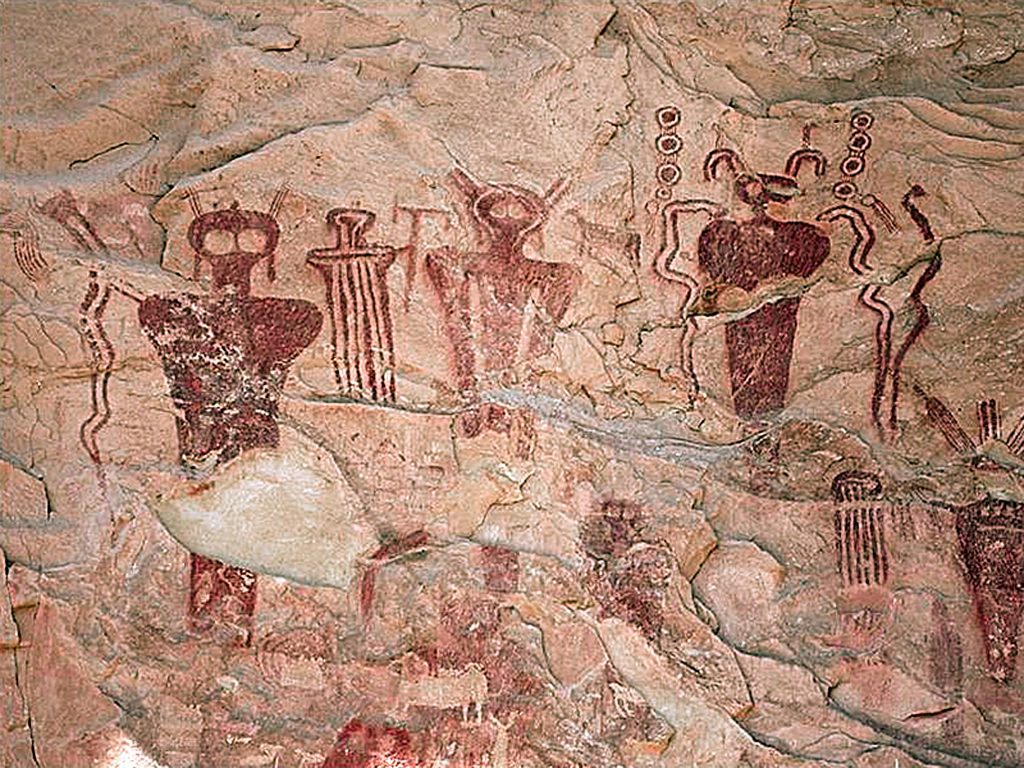
Photo by James Farmer, 2017; all rights reserved.
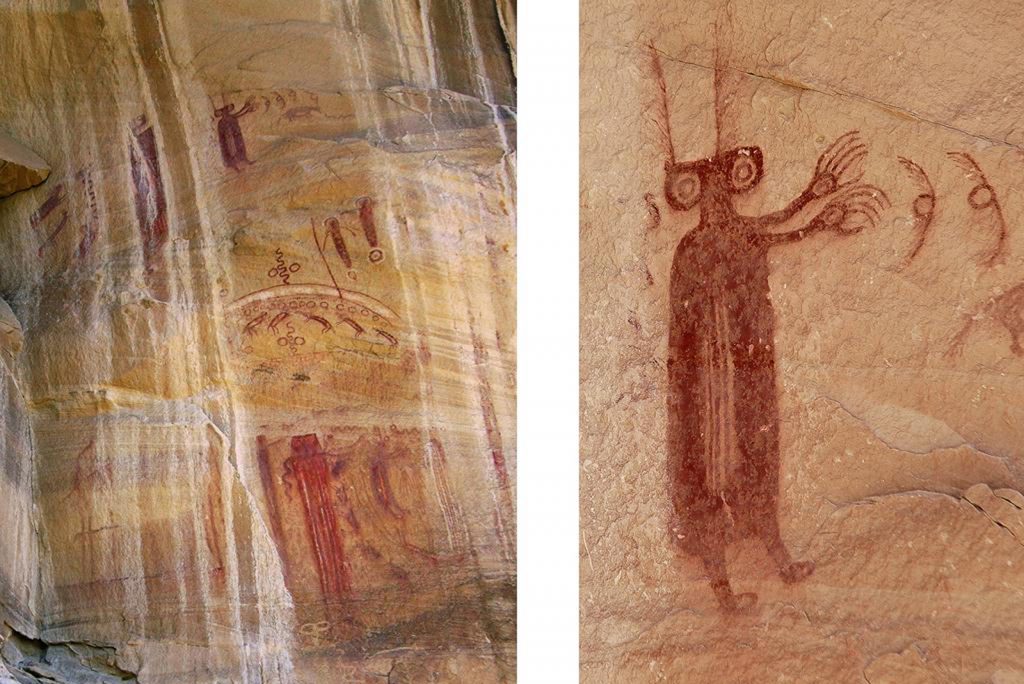
Left: BCS Style composition, San Rafael Swell, Utah, c.1000 BCE; overall height approximately 10 feet. At least seven anthropomorphs, three of which are clearly Thunderstorm God images, 15 animals or composite figures, including two vertical serpents, and numerous geometric motifs, including a rainbow, are presented in this complex composition.
Right: Detail from upper left, “Thunderstorm God” figure, c.30” tall. Note the linear “Waterfall” motif on the torso and fingers suggesting a gesture to create rain or waterfalls and the associated water streaking on the canyon wall. A bird in flight retreats from the waving hands. The figure is rendered with a distinctly three-quarter view of the head and upper torso (note the offset “antennae” and legs), as if frozen in motion while turning in or emerging from space to face the viewer as it engages in the gesture. This a rare example of a BCS Style anthropomorph depicted in such a dynamically rendered posture. The “antennae” (or possibly feathers) are rare appendages on BCS Style “Thunderstorm Gods”, but do occur more frequently on other BCS Style figures.
Photos by James Farmer, 2011; all rights reserved.
In 2007, I became Director of the BCS Project, a non-profit project based in Utah, established in 1992 and dedicated to creating a photographic database of all BCS Style rock art sites and imagery throughout the region, the vast majority of which is previously undocumented (BCS Project). Some readers may be familiar with one of the more famous examples of the BCS Style, known as the Great Gallery located in Horseshoe Canyon in a section of Canyonlands National Park, Utah (Figure 2.3). The Great Gallery consists of a series of over 200 figures ranging in size between c.1/2” and 7 feet, extending along a 200 foot section of sandstone wall. The figures are loosely grouped into about 20 discreet compositions, or “panels”, the most famous of which is known as the Holy Ghost Panel, frequently reproduced and cited in discussions of this style (Figure 2.4). Schaafsma first defined the style based on only 19 documented BCS style sites throughout the region (including the Great Gallery), an extremely small number of sites, leaving any sort of general interpretations somewhat speculative. However, by 2020, as a result of the BCS Project, the number of documented BCS Style sites throughout the region now exceeds 400, containing several thousand figurative and non-figurative elements. As a result of this vastly expanded inventory, more sophisticated and insightful interpretations are now possible.
BCS Style compositions typically occur on the vertical sandstone walls or in recessed alcoves of the dramatic canyons and drainages that define the southern Utah landscape. Many reasons influenced specific site locations, but one important reason is the fact that many locations exhibit dramatic geologic and climatic activities that actively alter the surrounding landscape. The local sandstone is relatively soft and highly susceptible to erosion and breakage, especially to wind and water, resulting in visually powerful settings and surfaces for rock art imagery (Figure 2.4). Such intense geologic and climatic vitality invests the region with overwhelming vistas of dramatic landscapes formed and being formed by powerful natural processes, vistas that inspire modern viewers and, no doubt, inspired the ancient inhabitants as well.
Many BCS Style panels display close visual awareness and interaction with the immediate rock surface and associated erosion features, frequently accommodating such features into the composition. The sandstone and its ongoing alterations become an active design element of the painted imagery. This often creates a perceived dimension of direct physical interaction between the viewer, the imagery, and the location, which further heightens a sense of “spirituality” frequently ascribed to BCS Style imagery. This effect is often enhanced by clear visual evidence in several scenes of the intentional depiction of spatial recession, or illusionistic 3-dimensional space. This assertion is not just the product of a visual or configurational interpretation; recent studies by Hampson (2016), Loubser (2006), and Whitley (2000), discuss the wide-spread shamanic belief that the canyon wall served as a pictorial “ground” indicating the sacred nature of the location, in that the solid wall is actually perceived as a spiritual membrane or portal through which supernatural entities move between the earthly and supernatural realms (i.e. 3-dimensional space extending beyond the canyon wall).
The compositional sophistication of BCS Style imagery is complemented by equally sophisticated technical aspects of the paintings. The larger, deep red-hued anthropomorphs required substantial amounts of paint mixed from natural materials readily available in the landscape, especially red iron-oxide pigment. Some large figures exceed six feet in height and nearly three feet in width, covering approximately 15 square feet of rock surface. In such instances, the pigment often approaches 1/8 inch thick in some areas. In addition to pigment, paint requires adhesive qualities to bind to its ground, so emollients and binders must be prepared in adequate quantity. And a reliable water source is required, to not only support the basic subsistence needs of the people, but to service such artistic production. A large, multi-figure BCS Style composition at a single site may contain hundreds of individual figures. The production alone of the necessary paint for these images (a need shared by other similar large-scale painting traditions such as the Pecos River Style) was no small task, especially for non-sedentary, migratory hunter-gathers who produced little else in the way of material culture.
Application techniques were equally as complex. While the larger visually “eye-popping” BCS Style anthropomorphs tend to dominate most scholarly work on the style (and garner the most “oohs” and “ahhs” from the casual viewer; re: Figure 2.4.), BCS artists actually produced figures across a wide range in scale, from the six-foot plus anthropomorphs to a wide variety of animal figures no more than 1/2 inch high. These miniscule figures require the viewer to place his/her face within just a few inches of the rock surface to even discern the figures, in contrast to the prerequisite greater distance, often a matter of many feet or yards (or more) to adequately perceive and comprehend the larger figures (cf. Morales, Jr., this volume, Figure 4.10). When combined with the matter of the natural rock surface visually functioning as part of the composition, discussed above, the experience of viewing a BCS Style painting is no passive event; it is a dynamic, physically engaging experience involving motion, time passage, spatial illusionism, and constant visual adjustment.
To create such wide variations in scale and perception, the artists employed the widest possible array of application techniques. Close scrutiny of individual painted elements across the entire inventory of BCS Style images reveals clear evidence of pigment being applied in large quantities via finger painting, direct smearing of handfuls of paint, large tufts or pads of animal skin or fur, or large “brushes” of plant fiber or leaves. Smaller, medium-sized brushes made of small branches, twigs, or plant stalks, probably similar to historically documented examples from early Puebloan communities, were used for smaller-scale figures and elements between one and three feet tall. At the smallest end of the scale, the miniscule animal figures, which contain some of the most articulate and extremely small details (“body adornments,” “dripping liquids,” or tiny linear serpents and birds), were painted with extraordinarily small implements. Brushes consisting of no more than two or three individual filaments (hairs), probably similar to those made from thin stalks of yucca leaves used by modern and historic Pueblo potters to create intimate details on vessel surfaces, were clearly used (cf. Figures 2.9, 2.10). A small wooden or bone “stylus” usually less than 1/8 inch thick with a small dab of pigment on the end was sometimes used to punch or tap rows of dots. Such small and intricately detailed BCS figures required a different quality of paint from that used on the larger anthropomorphs, and an extremely steady hand on the part of the artist, in contrast to the long, full length arm gestures and broad strokes required for the larger figures. The paint was thinner and more fluid, requiring a delicate, almost calligraphic touch reminiscent of the techniques of early Northern European Renaissance artists working with oil-based paints (not to mention extraordinarily good eyesight!). Indeed some type of arm or wrist support resembling the Renaissance mahl stick may have been employed for these tiny images. And, beyond directly applied techniques, paint was also splattered, thrown, and apparently spit, and many painted figures were subsequently altered by the use of sharpened or spade-shaped stone or bone implements to scrape or scratch away lines and rows of pigment to reveal the natural original rock tone below the pigment, adding texture and a sort of positive/negative reversal to the surface. BCS Style rock art panels are indeed quite sophisticated “paintings.”
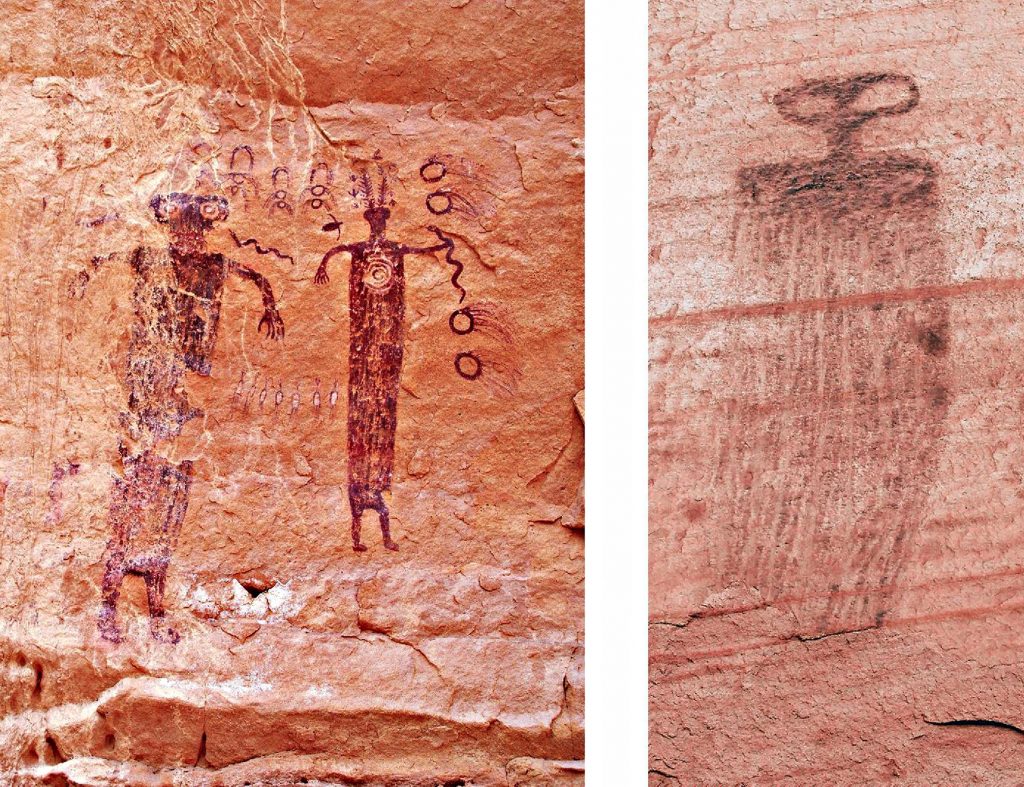
Left: Head of Sinbad Canyon, near Green River, Utah. Images occur on a vertical canyon wall, approximately 15 feet above current ground level. Large figures are c.3 and 4 feet tall. Note direct engagement of figures with white calcium carbonate water stains at left naturally deposited by waterfall runoff. (cf. Figure 2.5).
Right: Bartlett Flat, near Moab, Utah. Note the extensive “waterfall” vertical lines comprising the entire lower torso. Close scrutiny of the torso reveals that these lines are actually a combination of dozens of painted vertical lines which have then been carved or incised over with a series of vertical engraved lines. Close scrutiny also suggests that the figure may actually consist of a “Rain Cloud” band (the shoulders) with falling rain below, and a goggled-eyed head emerging from the top (anthropomorphic transformation in the act?!).
Photos by James Farmer, 2007; all rights reserved.
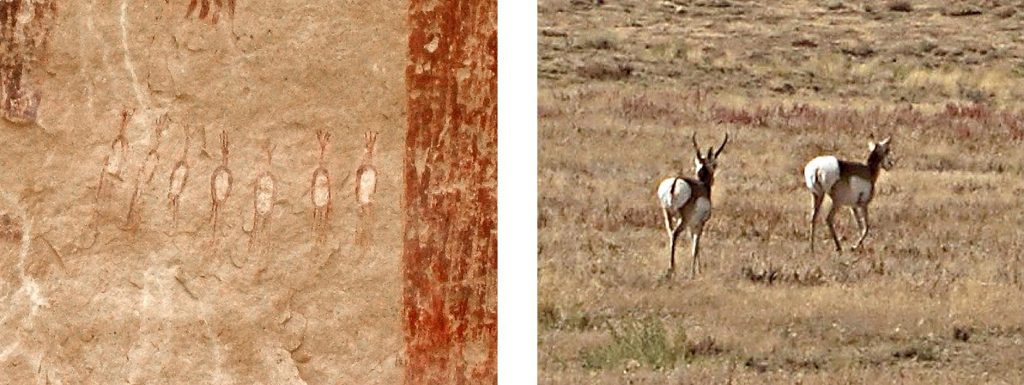
Photos by James Farmer, 2007; all rights reserved.
The BCS “Thunderstorm God” Iconographic Complex
In recent years, I have isolated and identified a distinct cluster of apparently iconographically-related figures and elements in many BCS Style compositions that recur throughout the region in more or less consistent associations. I have named this cluster the Thunderstorm God Iconographic Complex (Farmer 2017a, 2017b, 2018a). I have identified at least 20 distinct rock art panels exhibiting elements of this complex across the region. Using historic Puebloan ethnographies alone (Olsen; Patterson), which of course implicitly asserts some cultural continuity, I can assign more specific meanings to several common BCS Style elements in this complex (Figures 2.4 – 2.13):
- A frontal upright anthropomorph with exaggerated eyes (“Goggle-eyes”), typically accompanied by linear elements identifiable as atlatl darts or arrows, serpents, plant stalks, or lightning bolts, held or displayed vertically next to the figure. Anthropomorphs range in height from c.6” to over 6 feet in height.
- Individual linear elements rendered either vertically or horizontally and typically in zigzag form that clearly depict a serpent; some of these include additional elements of feathers, claws, or horns. These serpents usually appear to be free-floating within the overall composition. When depicted vertically, Puebloan ethnographies consistently identify these as symbols of water serpents, darts or arrows, or lightning. When depicted horizontally, they symbolize serpents or fast-flowing water, such as rivers, streams or flash floods. These serpents can range up to 20 feet in length, occasionally functioning as framing elements for an entire composition.
- A distinctive abstract element consisting of a horizontal band or elongated rectangle of solid color (usually red) across the upper portion of the composition; again, these can measure up to 12 feet long. Some examples have a serrated or knobby top edge. These bands are typically accompanied by a series of vertical lines, sometimes so dense and numerous they resemble a curtain or screen, other times descending from the bottom into the composition. Occasionally, similar vertical lines descend from outspread hands of the anthropomorph, or appear on the torso, apparently as a form of body adornment. Puebloan ethnographies consistently identify this element as a rain or storm cloud with falling water below; this falling water may be rain or waterfalls, a common effect of thunderstorms in this canyon country where many BCS Style sites are located (cf. Figures 2.4 – 2.13).
- Upward arching semicircular arcs, consisting internally of a series of nested bands, also usually arching above the main composition, substituting for the above “rain” band. Universally identified in Puebloan ethnographies as a “rainbow.”
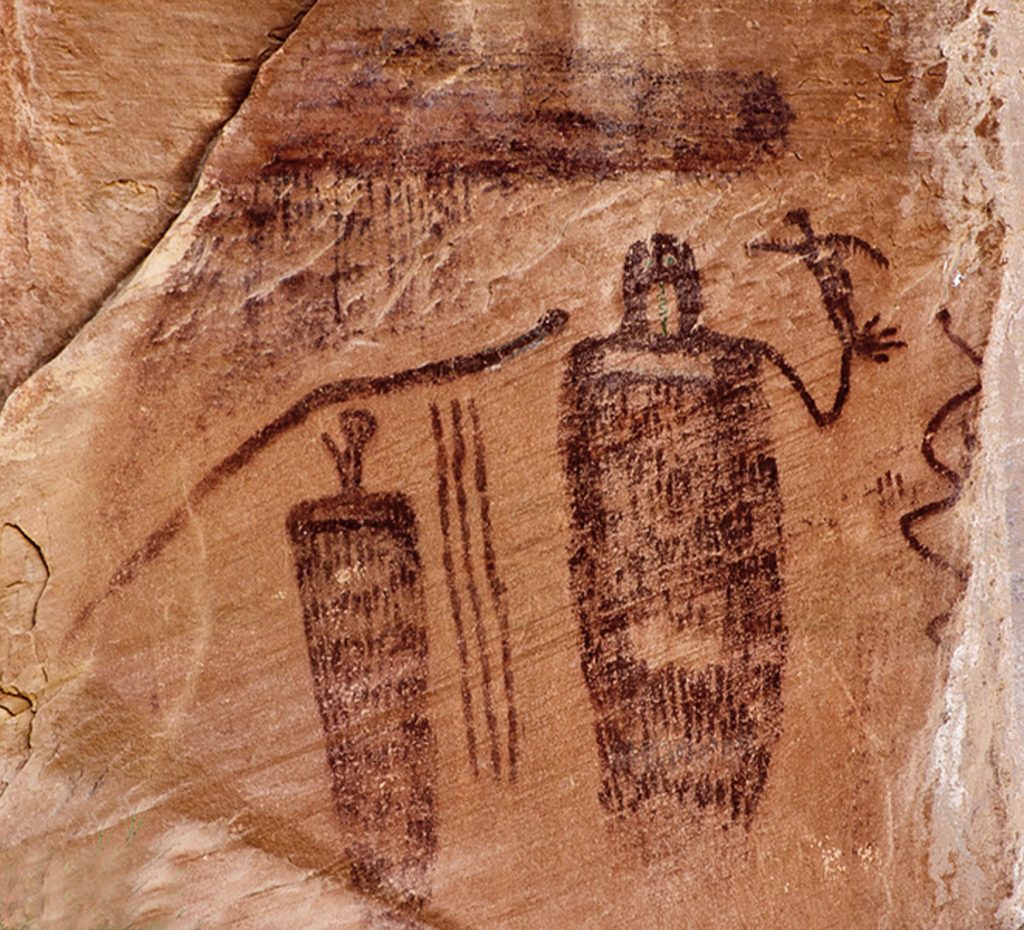
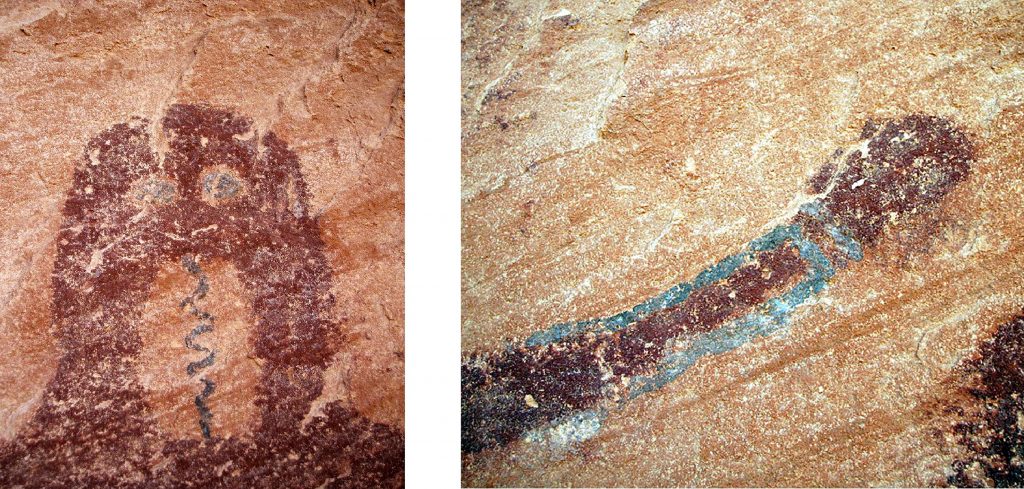
Left: Head of the right-hand figure. Note the exaggerated “goggle” eyes with green pupils, and the green lightning bolt/serpent in the mouth. Throughout both the Puebloan and Mesoamerican worlds, shades of green and blue are symbolically associated with water, fertility, and creation (Miller, this volume, page 2), and the image of a serpent in the mouth recalls historic photographs of the Hopi Snake Dance, traditionally performed in late summer to encourage seasonal rain storms, in which priests display snakes carried in their mouths (Frigout 1979: Fig. 14).
Right: Head of the horizontal serpent. Note the green “necklace” and stripes, perhaps indicating water.
Photos by James Farmer, 2007; all rights reserved.
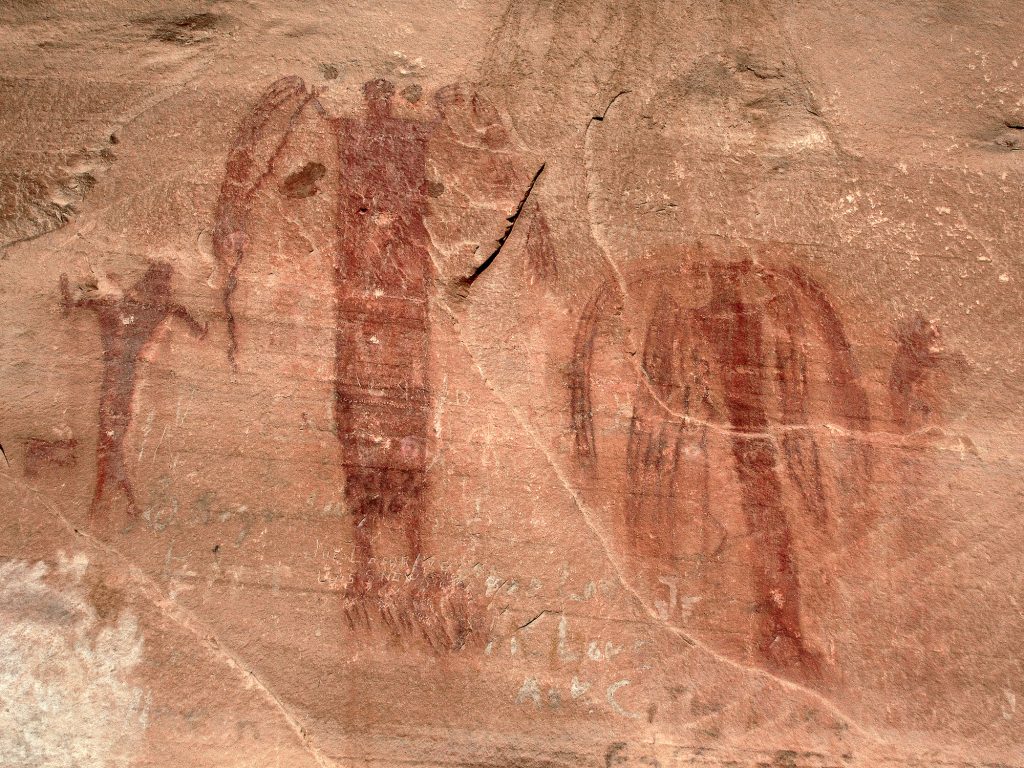
Photo by James Farmer, 2011; all rights reserved.
Having defined this complex, I realized that the elements articulated above generally match many of the major iconographic elements associated with two major, related deities in ancient and historic Southwestern and Mesoamerican thought: Sotuknangu, a principal Hopi god of creation, and its Aztec / Nahuatl equivalent, Tlaloc, the same goggle-eyed Aztec Rain God previously identified with early BCS Style images.
The major iconographic elements and associations for both the Aztec Tlaloc and Hopi Sotuknangu are well documented, and require no in-depth ethnographic excavation herein. Additionally, in a 1994 essay comparing Western Puebloan and Mesoamerican ideologies, M. Jane Young charts the complex iconographic parallels between major Aztec and Western Pueblo (Hopi, Zuni) deities, revealing numerous points of iconographic overlap between Tlaloc and Sotuknangu (Young 1994: 109). Similarly, a close relationship between Mesoamerican and Puebloan horned or feathered serpents has long been recognized by Schaafsma (2001). Rain God and Feathered Serpent iconographies are not mutually exclusive; Tlaloc and Quetzalcoatl share numerous iconographic features (at least according to Young). Images of Tlaloc are well-familiar to Mesoamerican specialists and non-specialists alike; it is one of the most often-depicted entities in Mesoamerican art (Figure 2.14), and widely exploited in modern times. Conversely, and perhaps ironically, depictions of Sotuknangu are extremely rare. The most common depictions of Sotuknangu are found in symbolic ceremonial costumes associated with historic Pueblo ceremonies, and small carved figurines placed around modern ceremonial altars, or produced for a modern commercial market. Admittedly, these recent historic versions bear little stylistic resemblance to the BCS Style figures under consideration, but they are very much the products of heavy influence from a variety of different “foreign” cultures and processes since the 16th century.
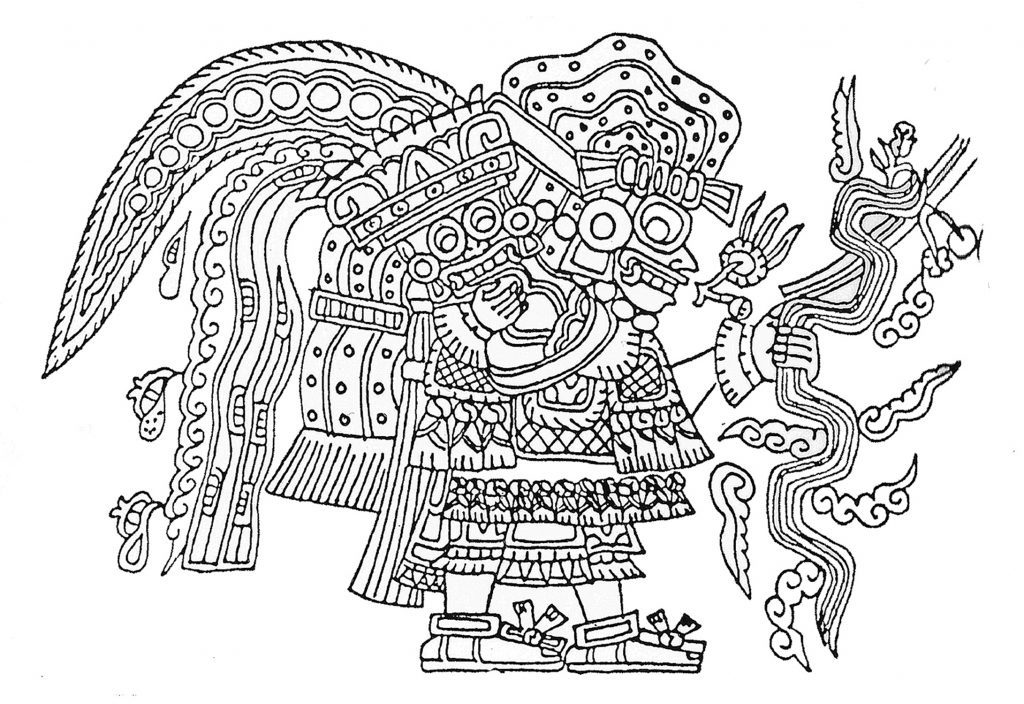
Redrawn by James Farmer from Berrin 1988: Figure VI.18, p. 190.
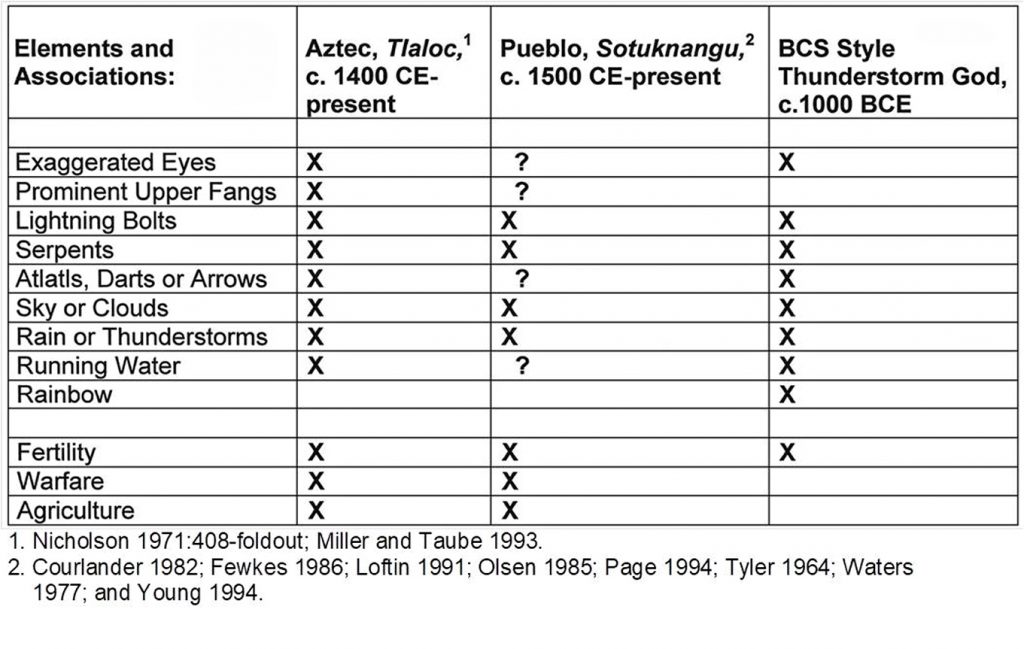
Chart 2.1 presents a comparison of the basic iconographic features of Tlaloc, Sotuknangu, and the BCS Style Thunderstorm God, merely to clarify the bases for the interpretation suggested herein. The numerous ethnographic sources on Hopi myths, religion, and ceremonialism provide ample information about their creation mythology. Though different versions vary in some details, the comparisons in Chart 1 are generally accurate. I offer it simply to underscore the significance of Sotuknangu.
Hopi creation tales tell us that the First World was endless space. Taiowa, the Sun God, created his nephew Sotuknangu and charged him with creation of the first nine universes, the fourth of which is the one occupied by modern Hopi society. Sotuknangu created Kokyangwuti, “Spider Woman,” who in turn created all life on earth, as well as knowledge, wisdom, and love. Spider Woman then created the (sometimes “war”) twins, Poqanghoya and Palongawhoya, to maintain balance on earth and in the universe. Even this brief description of Hopi creation mythology clearly reflects the importance of Sotuknangu, who I would assert has probably been a most significant mythic figure (god?) in Hopi and pre-Hopi culture for centuries or even millennia. Some version of such an important entity and its associated iconography must surely date well-back in time, and therefore be more susceptible to Panofsky’s “disjunction between form and meaning.”
One critical issue is the lack of reasonably fixed dates for the BCS Style. If the BCS Thunderstorm God images generally date before c.1500 BCE, then they predate the Olmec fluorescence in Mesoamerica and the adoption of intensive agriculture in the Southwest, hence a lack of agricultural iconography, and probably warfare associations as well, given the lack of permanent settlements. Warfare and agricultural iconography associated with the later Tlaloc and Sotuknangu complexes may reflect the adaptation of an established fertility/creation deity to a new cultural paradigm (sedentism and intensified farming).
However, the range of some BCS Style images (including the Great Gallery) may be later in date (c. 1000 BCE to 1000 CE), thus contemporary with the early sedentary phases of Ancestral Puebloan culture and the advanced cultures of Mesoamerica (Olmec, Zapotec, Teotihuacan, Classic Maya, and perhaps even Toltec). In this case, a very different relationship will have to be defined, but such a scenario is still very much a product of the same interpretative approach.
This line of research is still in its infancy, with much work yet to do, and, admittedly, Grieder’s methodology discussed here is now 50 years old, and therefore somewhat dated or perhaps superseded by more recent theoretical advances in art historical scholarship. But the progress achieved so far, at the very least, suggests further avenues of investigation. I offer these speculations at this point only as a premise for such continued investigation, but the implications seem large. The ancestral origins of modern Puebloan societies, including Hopi, are generally dated to c. 2000-1500 BCE. Do BCS Style Thunderstorm Gods indicate even substantially deeper cultural and religious roots in the antiquity of the region? Is it feasible to conceive of the BCS Style Thunderstorm God as a very early manifestation of the same entity that eventually evolves into the Pueblo god Sotuknangu, or the Aztec god Tlaloc? The interpretive method championed by Grieder in his early scholarship at least allows us to ask such questions, and search for answers based on rational, grounded research and critical analysis of available data, rather than romantically seeking some divinely-inspired Mesoamerican “Michelangelo.”
I close this essay by offering one final quote by Grieder from “The Interpretation of Ancient Symbols,” the statement that concluded his essay as well. If the reader has indulged me to this point, it will be most apparent that this statement not only reflects the essence of the discussion contained herein, but indeed my general adherence to its assumptions and application, my own “working methodology” as it were, at least as far as ancient rock art imagery is concerned:
With a full catalogue of images, with the archaeological record, including ceramics, with an awareness of evidence of disjunction, and with historical and ethnographic records to provide one end of the traditions of content, we can attain reasonably good descriptions of the more recent prehistoric cultures, and at least increase the evidential base for speculation about the remote ones. (Grieder 1975: 853-54).
Notes
1. Strictly speaking, the commonly used designation “rock art” as a distinct artistic medium actually has little validity as an art historical concept. Typical “rock art” images are in fact paintings, drawings, or shallow to relatively deep relief carvings or engravings. The term “rock art” actually originated in early archaeological scholarship, but it is now so deeply entrenched in modern scholarship, that its use is retained herein. Semantic challenges to its use here are beyond both the scope and focus of this essay.
2. Anthropologist Paul Kirchhoff first coined the terms “Aridoamerica” and “Oasisamerica” to describe the combined Pre-Columbian culture areas of far northern Mexico (i.e. northern Mesoamerica) and the southwestern United States. “Oasisamerica” is generally preferred by Mexican archaeologists, whereas “Greater Southwest” is commonly used by American (United States) archaeology for the same area.
Works Cited
BCSProject, http://bcsproject.org, accessed January 19, 2021.
Berrin, Kathleen, ed.
1988 Feathered Serpents and Flowering Trees. San Francisco: The Fine Arts Museums of San Francisco.
Binford, Lewis R.
1962 “Archaeology as Anthropology”, American Antiquity, Vol. 28, No. 2, pp. 217-Cambridge, England: Cambridge University Press.
Boyd, Carolyn
2016 The White Shaman Mural: An Enduring Creation Narrative in the Rock Art of the Lower Pecos. Austin: University of Texas Press.
Clancy, Flora
1984 “Review of Origins of Pre-Columbian Art by Terence Grieder”, The Americas, Vol. 41, No. 1, pp. 132-134. Cambridge, England: Cambridge University
Press.
Coe, Michael D.
1978 Lords of the Underworld: Masterpieces of Classic Maya Ceramics. Princeton: Princeton University Press.
Cohen, Simona
1998 “Some Aspects of Michelangelo’s Creative Process”, Artibus et Historiae, Vol. 19, no. 37, pp. 43–63. Krakow, Poland.
Crosby, Harry W.
1975 The Cave Paintings of Baja California: Discovering the Great Murals of an Unknown People. San Diego: Sunbelt Publications.
Courlander, Harold
1982 Hopi Voices: Recollections, Traditions, and Narratives of the Hopi Indians. Albuquerque: University of New Mexico Press.
Farmer, James
2001 “Goggle Eyes and Crested Serpents of Barrier Canyon: Early Mesoamerican Iconography and the Archaic Southwest”. In The Road to Aztlan: Art From a Mythic Homeland, pp. 124-137. Virginia M. Fields, ed. Los Angeles: Los Angeles County Museum of Art.
2008 “Thunderstorm Iconography and Site Locations in the Barrier Canyon Style”, Papers from the Utah Rock Art Research Association Annual Symposium, Salt Lake City: Utah Rock Art Research Association.
2017a “God Before Corn: Rock Art and the Origins of a Pre-Agriculture Thunderstorm God in Ancient America”, paper presented at the Society for American Archaeology Annual Conference, Vancouver, Canada.
2017b “Before Corn: “Sotuknangu” and the Origins of the Gods in Archaic America”, paper presented at the Utah Rock Art Research Association Annual Symposium, Green River, Utah.
2018a “Tlaloc, Sotuknangu, and the Origins of the Gods in Ancient America: The Case of Barrier Canyon Rock Art”, paper presented to the Precolumbian Society of Washington D.C. Annual Meeting, Washington D.C.
2018b The White Shaman Mural: An Enduring Creation Narrative in the Rock Art of the Lower Pecos, College Art Association Book Reviews. http://www.caareviews.org/reviews/3239#.YAUIzBZ7mgg. Accessed 17 Jan. 2021
Fewkes, J. Walker.
1986 Hopi Snake Ceremonies. Albuquerque, New Mexico: Avanyu Publishing Inc. (Republication of Bureau of American Ethnology Annual Report Nos. 16: 1894–1895, and 19: 1897–1898).
Frigout, Arlette
1979 “Hopi Ceremonial Organization”. In Handbook of North American Indians, Vol. 9, Southwest. William Sturtevant, Gen. ed.; Alfonso Ortiz, Vol. ed., Washington D.C., Smithsonian Institution, pp. 564-576, Fig. 14.
Gebhard, David
1960 Prehistoric Paintings of the Diablo Region – A Preliminary Report. Roswell, New Mexico: Roswell Museum and Art Center, Publications in Art and Science, No. 3.
Grieder, Terence
1960 “Manifestaciones de Arte Maya en La Region de Petexbatun”. Antropologia e Historia de Guatemala, Vol.12, No. 2, pp. 10-24. Guatemala: Ministerio de Educación Pública, Instituto de Antropologia e Historia de Guatemala.
1962 The Development of Representational Painting on Pottery of the Central Maya Lowlands During the Proto-Classic and Classic Periods. PhD dissertation, Philadelphia: University of Pennsylvania.
1964 “Representation of Space and Form in Maya Painting on Pottery”, American Antiquity, Vol. 29, No. 4, pp. 442-448. Cambridge, England: Cambridge University Press.
1966 “Periods in Pecos Style Pictographs”, American Antiquity, Vol. 31, No. 5, Part 1, 710-720. Cambridge, England: Cambridge University Press.
1975 “The Interpretation of Ancient Symbols.” American Anthropologist 77 (4): 849–55.
1978 The Art and Archaeology of Pashash, Austin: University of Texas Press.
1982 Origins of Pre-Columbian Art. Austin: University of Texas Press.
1986 “Recording and Interpreting Lower Pecos Pictographs”, in Ancient Texans: Rock Art and Lifeways Along the Lower Pecos. Harry J. Shafer, ed. San Antonio: Witte Museum of the San Antonio Museum Association, pp. 176-179.
Hampson, Jamie
2016 “Embodiment, Transformation and Ideology in the Rock Art of Trans-Pecos Texas”, Cambridge Archaeological Journal, No. 26: 217-241; doi:10.1017/S0959774315000505.
Janetski, Joel C. and Richard K. Talbot
2014 “Fremont Social Organization: A Southwestern Perspective”. In Archaeology in the Great Basin and Southwest, Papers in Honor of Don D. Fowler, pp. 118-129. Nancy J. Parezo and Joel C Janetski, eds. Salt Lake City, Utah: University of Utah Press.
Keener, Katherine
2019 “Must see – Exhibitions, Michelangelo: Mind of the Master”, Art Critique, online journal, Paris, France. https://www.art-critique.com/en/2019/09/exhibition-of-drawings-by-michelanglo/. Accessed 17 Jan. 2021.
Kubler, George
1970 “Period, Style and Meaning in Ancient American Art.” New Literary History, 1(2): 127–44. https://doi.org/10.2307/468624.
Lekson, Stephen H.
2008 A History of the Ancient Southwest. Santa Fe: School for Advanced Research Press.
Liponi, Don, et al.
2016 La Rumorosa Rock Art Along the Border: A Survey of Kumeyaay and Related Artwork in Southern California, Colorado River Corridor, Western Arizona and Baja California, Vol. 1. Louisville, Kentucky: Four Colours Print Group.
Loftin, John D.
1991 Religion and Hopi Life in the Twentieth Century. Bloomington & Indianapolis: Indiana University Press.
López Austin, Alfredo and Leonardo López Luján
2001 Mexico’s Indigenous Past. Norman: University of Oklahoma Press.
Loubser, J.H.N.
2006 “Rock art, Physical Setting, and Ethnographic Context”. In Talking With the Past: The Ethnography of Rock Art, pp. 225–48. J.D. Keyser, et al., eds. Portland: Oregon Archaeological Society Publications.
Merriam-Webster Dictionary
2021 Merriam-Webster Online Dictionary, https://www.merriam-webster.com/dictionary/create. Accessed 17 Jan. 2021.
Miller, Mary and Karl Taube
1993 An Illustrated Dictionary of The Ancient Gods and Symbols of Ancient Mexico and the Maya. London: Thames and Hudson, Ltd, p.166.
Morss, Noel
1931 The Ancient Culture of the Fremont River in Utah, Report of the Explorations of the Claflin-Emerson Fund, 1928-1929. Cambridge, Massachusetts: Papers of the Peabody Museum of American Archaeology, Vol. XII, no. 3.
Nicholson, Henry B.,
1971 “Religion in Pre-Hispanic Central Mexico”. In Handbook of Middle American Indians, Vol. 10, Robert Wauchope, General Editor. Austin: University of Texas Press.
Olsen Nancy H.
1985 Hovenweep Rock Art: An Anasazi Visual Communication System, Occasional Paper 14. Los Angeles: Institute of Archaeology, University of California.
Page, Susanne and Jake Page.
1994 Hopi. New York: Harry Abrams.
Patterson, Alex
1992 A Field Guide to Rock Art Symbols of the Greater Southwest. Boulder, Colorado: Johnson Books.
Proskouriakoff, Tatiana
1960 “Historical Implications of a Pattern of Dates at Piedras Negras, Guatemala”, American Antiquity, Vol. 25, No. 4, pp. 454-475. Cambridge, England: Cambridge University Press.
1963 “Historical Data in the Inscriptions of Yaxchilan, Part 1”, Estudios de Cultura Maya, Vol. III. Mexico City: Universidad Nacional Autónoma de México.
1964 “Historical Data in the Inscriptions of Yaxchilan, Part 2”, Estudios de Cultura Maya. Vol. IV. Mexico City: Universidad Nacional Autónoma de México.
Schaafsma, Polly
1971 The Rock Art of Utah: From the Donald Scott Collection. Boston: Peabody Museum of Archaeology and Ethnology, Harvard University.
1980 Indian Rock Art of the Southwest. Albuquerque, New Mexico: School of America Research Southwest Indian Arts Series.
1999 “Tlalocs, Kachinas, Sacred Bundles, and Related Symbolism in the Southwest and Mesoamerica”. In The Casas Grandes World , pp. 164-192. Curtis F. Schaafsma and Carroll L. Riley, eds., Salt Lake City: University of Utah Press.
2001 “Quetzalcoatl and the Horned and Feathered Serpent of the Southwest”. In The Road to Aztlan: Art From a Mythic Homeland, pp. 138-149. Virginia M. Fields, ed. Los Angeles: Los Angeles County Museum of Art.
Shafer, Harry J.
1986 Ancient Texans: Rock Art and Lifeways Along the Lower Pecos. San Antonio: Witte Museum of the San Antonio Museum Association.
Smith, Michael E.
2010 “Trading Patterns, Ancient American”. In Berkshire Encyclopedia of World History, 2nd Edition,pp. 2533-2538. Great Barrington, MA: Berkshire Publishing Group LLC.
Smith, Robert Eliot
1955 Ceramic Sequence at Uaxactun, Guatemala. New Orleans: Middle American Research Institute, Tulane University.
Stokstad, Marilyn and Michael W. Cothren
2020 Art: A Brief History, Seventh Edition. United States: Pearson Education.
Sorensen, Lee, ed.
2021 “Kubler, George.” Dictionary of Art Historians (website). https://arthistorians.info/kublerg.
Moholy-Nagi, Hattula
2012 Historical Archaeology at Tikal, Guatemala, Tikal Report No. 37 (Series Editors William A. Haviland and Christopher Jones). Philadelphia: University of Pennsylvania Museum of Archaeology and Anthropology.
Tyler, Hamilton
1964 Pueblo Gods and Myths. Norman: University of Oklahoma Press.
Waters, Frank
1977 Book of the Hopi. New York: Penguin Books.
Whitley, David
2000 Art of the Shaman, First Edition. Salt Lake City; University of Utah Press.
Wyndham, Felice.
2011 “The Semiotics of Powerful Places: Rock Art and Landscape Relations in the Sierra Tarahumara, Mexico”, Journal of Anthropological Research, Vol. 67, No. 3: pp. 387-420. Albuquerque: University of New Mexico Press.
Young, M. Jane
1994 “The Interconnection Between Western Puebloan and Mesoamerican Ideology / Cosmology”. In Kachinas in the Pueblo World, Polly Schaafsma, ed., pp. 107-120. Albuquerque: University of New Mexico Press.

